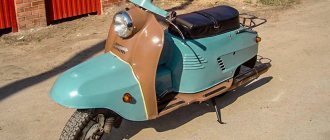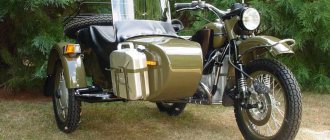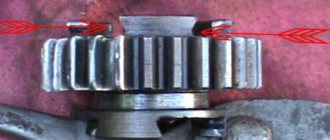When talking about modern mopeds, most people think of various Japanese and Chinese brands, since they are the ones that have now flooded the market for two-wheeled vehicles for urban use.
But there was a time when there was no talk of any mopeds from Japan or China. During the Soviet era, people rode exclusively on Soviet equipment. This applied to both cars and two-wheeled motor vehicles.
Yes, imported cars and motorcycles gradually began to appear. But still, the vast majority of people owned exclusively Soviet technology.
And among all the assortment available at that time, it is worth highlighting the Tourist scooters. They quickly gained popularity and fully met the expectations of consumers. High quality, reliable, easy to operate and maintain.
Review of "Tourist"
The “Tourist” scooter was characterized in its years as a reliable vehicle for transportation. Production of the model began in 1968. This unit is a prototype of the Tula scooter. On this scooter, the tool box is located in the front wheel housing. The battery is located between the driver's legs. “Next door” to the front brake, a shock-absorbing system is provided. It is characterized as soft and reliable. In the parking position, the support is provided by the central and lateral legs. Unlike its “successors”, the engine of the “Tourist” scooter has less power. The so-called neutral speed is located before the first speed. At the same time, two models were launched: “Tourist” and “Tourist-M”.
History of creation
The development and production of the scooter, which was called the Tourist, was carried out on the basis of the Tula Machine-Building Plant (TMZ). The first ideas for a new project appeared in the early 1960s. But implementation began a little later, since at that time the Tula motor scooter was still being produced, which was still relevant and in demand.
In the early 60s, the design bureau of the Tula plant was tasked with developing a new Soviet scooter, the Tourist. In 1965, E.N. became the head of the design bureau team. Shcherbakov, and the chief designer was A.V. Lototsky. Through joint efforts, we managed to significantly improve previous projects and create a completely new product.
Full production of Tourists began in 1968.
The name Tourist was not invented just like that. The authors of the project intended that this two-wheeled vehicle would allow people to travel not only within the city, but even to travel around the country.
The basis for creating the new product was previous scooters. These were the T-200 and T-200M models. At the same time, the difference in design turned out to be more than significant. And in technical terms, the new product has surpassed its predecessors.
By using a load-bearing hood, engineers were able to eliminate the need to use a massive tubular subframe at the rear of the two-wheeled vehicle. There is also a new linkage front fork. The design was of a pushing type, which had a positive effect on handling. Although it was not without certain shortcomings in the end. But this is hardly surprising. Cons can be found everywhere and in everything.
Before being put into assembly line production, the scooter went through many tests. First at the stands of the Tula plant, then at the Motoprom Research Institute. The equipment was also tested for durability and efficiency in mountainous terrain and they did not forget to walk along snow-covered country roads.
Moreover, TMZ athletes used Tourist scooters when taking part in the national all-around championship on motorcycles, rode cross-country courses and raced on ice. The tourist performed well in the FIM motorcycle rally, which took place in 1965 and 1966. That is, even before the official start of production of the scooter.
The owners of the Tourist themselves at one time discovered a number of shortcomings and shortcomings. But if we talk about the scooter in general, then this is an excellent solution. Quite comfortable and reliable, easy to maintain and operate.
Another confirmation of the viability of the project and competent work on the new project was participation in the All-Union motorcycle competitions for the championship of the brand. It was here that the Tula plant, armed with Tourist scooters, won first place and took the main prize. This happened in 1967.
After 2 years, TMZ almost managed to repeat its past success. Competing with production motorcycles, the Tourist scooter eventually won second place. But it also clearly showed how successful the project is.
Motor scooter "Tourist"
Particular attention should be paid to the cleanliness of the engine surface. There should be no dirt on the cylinder and its head. Otherwise, it may adversely affect the heat transfer of the engine. There have also been cases of rapid wear of parts, which in turn leads to unexpected stops during movement.
To avoid fire, there should be no traces of gasoline or oil on the power unit. Due attention should be given to the lubrication of the productive element. Under no circumstances should you be allowed to ride a scooter that is only filled with gasoline. It is imperative to fill the fuel tank with a mixture of gasoline and oil. Otherwise, all parts will wear out quickly.
Scooters from the USSR
The Soviet Union had its own approach to solving state problems.
There was a society that was building communism, and everyone had “equal” rights and national property. Information from the outside world seeped in weakly but inexorably. Global scientific and technological progress pushed the country towards the abyss and successfully pushed it in 1991. Before that, the USSR was somehow developing and one day began producing motor scooters, which were so popular in Europe at that time. Society happily accepted the innovation, because the desired car was not available to the masses. And a motor scooter is a fairly comfortable vehicle that could be bought for two salaries. And the process began. State level In 1955, a meeting of the USSR government was held, at which the problems of producing motor scooters were resolved (the word “scooter” was alien to Soviet people). Already in December 1956, Resolution No. 825 was adopted, and a little later a decree, which launched the proper mechanism in this sector of mechanical engineering. To do this, production facilities had to be created. The choice fell on two military plants: Tula Machine-Building Plant named after. Ryabikova (TMZ) and the Vyatsko-Polyansky Machine-Building Plant (VPMZ), located in the village of Vyatskie Polyany, Kirov Region. Workers from the Central Experimental and Design Bureau of Motorcycle Manufacturing (TsEKB) (Serpukhov, Moscow region) were also involved in production.
The first to roll off the assembly line were the Tula T-200, a copy of the Goggo-roller TA200, originally from Germany, and the Vyatka VP-150, copied from the Italian Vespa 150. In 1956, they planned to produce 10 test cars, and in 1957, to launch the Vyatka VP-motor scooter. 150 into mass production. How did VPMZ begin to produce something other than weapons? Everything happened in stages. First, we established connections with the Izhevsk plant, which produced motorcycles and components for them. They began making mufflers, air pumps, steering wheels, etc. for it. The initial experience turned out to be successful. In general, under the conditions of command-administrative management of the country, relationships between enterprises were established quite easily - with one strong-willed decision of the government. But the more plants and factories there are, the more difficult it is to manage them. Having conscientiously established the production of new products, we purchased the appropriate equipment, but problems with intermediaries did not allow us to start production. And now the ice has broken. In 1957, mass production of Vyatka VP-150 scooters was launched. By the end of the year, 1,668 units of equipment had already been produced. The scooter immediately became popular. The convenient, visually pleasing, relatively inexpensive device attracted not only men, but also women. They could be calm - while driving, thanks to the lining, the skirt did not get dirty. Vyatka had its drawbacks: the hard metal floor often led to broken legs when falling to the side. In addition, operation was impossible without a “13” key, which was in short supply before the release of the Zhiguli. Based on this model, tricycles MG-150P (platform), MG-150S (dump truck), MG-150F (van) and others were produced.
A carbon copy Was the scooter made from scratch? The government took the familiar path of copying models from other countries (think motorcycles). At that time, there was a boom in scooter popularity in Europe; many manufacturers joined this trend, which made it possible to make a good choice. Scooters from Piaggio and Innocenti were tested. For this purpose, a test run of 2,000 km was carried out. The confrontation between Vespa and Lambretta in difficult conditions of Soviet roads showed the advantage of the latter. But they took the Italian Vespa GS150, which was extremely popular in Europe, as a model. Why? It was not possible to find an answer to this question, but perhaps due to the complex design of the Lambretta and the pleasant appearance of the Vespa. Having studied the scooter in detail, we made a copy with some differences: the inscription “Vyatka” and a red flag with a five-pointed star, a modified ignition switch, the shape of the muzzle and the dashboard, as well as technical details. A special feature of Vespa is pre-compression of the rear shock absorber spring, which is not inherent in Soviet motorcycle construction, except for sports motorcycles. The big drawback is that the Italian is difficult to drive on bad roads. The operating conditions of Vespa and Vyatka are different, therefore the scooter had to be modernized. The number of scooters produced in 1962 was 100,000 - an average of 20,000 units per year. In 1965, they developed a new model - Vyatka VP-150M, which differed from the previous one both externally and technically. Throughout 1966, both models were produced in parallel, but towards the end the Vyatka VP-150 was discontinued. Rationalization For the modernized development, VPMZ received a diploma from the Exhibition of Achievements of the National Economy. The engine remained old, but changes affected the chassis and design. Copying moved aside, and Soviet engineers showed their abilities. The differences were striking. The scooter body was made collapsible for ease of transportation, the engine was moved to the center, the air filter and carburetor were changed, a push-type lever fork with two large shock absorbers and a more powerful shock absorber appeared at the rear. Driving capabilities have increased several times to the detriment of comfort, design and cladding. Power, of course, has increased, but the problem remains the heavy weight. True, this did not stop the process. The next modification of Vyatka was called Electron, associated with an electronic contactless ignition system. By the way, it was used for the first time in the history of the country’s mechanical engineering at Vyatka, lagging behind its Japanese counterparts by only four years, which, however, were temporarily inferior to the Soviet ones. The scooter's compression ratio has increased, which, accordingly, has added power to 7 hp. and speeds - up to 80 km/h. Many changes have been made to the design, the scooter has become more convenient and practical. But the main thing is that quality has increased while prices have fallen - what else does the consumer need? In general, scooters, like other equipment in the USSR, were developed taking into account ease of repair. “Pregnant” with glory The production of the Vyatka series ended in 1979, and VPMZ returned to the production of weapons. This was due to a decrease in demand as the car became more affordable. But spare parts for the scooter were produced for another five years. Vyatka was actively exported to developing countries and even to Europe, where demand was explained by low price, not quality. In developing countries, the quality of the scooter satisfied consumers completely. Vyatka was supplied to 50(!) countries of the world. A memorable year for the plant is 1975, when the millionth scooter rolled off the assembly line. This is the record. In general, the Vyatka in all modifications had a simple and practical engine, which earned respect due to its “indestructibility”. The history of the scooter goes back 22 years, 1.7 million scooters and the nickname “pregnant” - for its specific rear end. The influence of the Vyatsko-Polyansky Machine-Building Plant on the village is interesting, which already in 1942 received the status of a comfortable city, producing not only military products, but also general consumption. Motor scooters brought not only income, but also prestige, social significance and weight in society. Tu-lu-la! Tula Machine-Building Plant named after. Ryabikov produced scooters based on the Goggo-roller TA200 (manufactured in Germany, Hans Glas GmbH). The German had engine displacement variations: 125, 150 and 200 cm3. The prototype was a flagship with a 200 cc engine. They also looked closely at the French Peugeot and German Puch. But we settled on Goggo, which is suitable as an alternative to Vyatka. The consumer should have a choice! Compared to Vyatka, the scooter was more powerful and heavier. Similarities with the original were not avoided, but Soviet production left its mark. The Tula T-200 scooter began to be produced in 1957. The scooter was equipped with an 8-horsepower 199 cm3 engine with a 4-speed gearbox and chain drive of the rear wheel, 10-inch wheels, and a long-link push-type pendulum fork of the front suspension. Weight -155 kg, maximum speed - 80 km/h. Tula differed from Goggo in its rather rare monotube shock absorbers and the absence of a kick starter. Instead, they used a more efficient electric start. The scooter came with a spare wheel - a necessary thing on long trips.
In addition to the T-200, they launched production of a cargo version of Tula - TG-200. To help TMZ, they brought in the TsEKB of the motorcycle industry, which developed the power unit, gearbox and electrical equipment. TMZ's task was to build bodies and chassis. The device had good cross-country ability, as evidenced by the repeated trips of enthusiasts to thousands of kilometers of the vast homeland. Modernization Since the production of scooters was just getting started, improvements were not long in coming. Already in 1962, the T-200M model was launched into production, which lasted until 1968. The changes affected the appearance and the engine and chassis. Power increased to 9 hp. with a reduced weight of up to 145 kg. The type of front fork was changed to a pulling one.
Five years later (1967) a new modification was developed. It was a Tourist: long-link pusher fork, old, but boosted to 11 hp. engine, a maximum speed of 85 km/h and a 12 liter tank, which is quite good with a fuel consumption of 3-3.5 liters per 100 km. The name spoke for itself - the scooter is designed for long distances. This was facilitated by forced cooling, as well as the correct chassis. However, the heavy weight and small wheels significantly reduced the dynamics and maneuverability of the scooter. Another headache for the owners was the electrical system. The production of batteries for it was poorly organized, not to mention the low quality. The next modification acquired the prefix “M”, respectively - Tourist-M. Its main difference is an aluminum cylinder with a steel sleeve instead of a cast iron one. A new cigar-shaped muffler was responsible for aesthetic pleasure. The development of engineering did not stop there. Reducing weight and increasing power remained the main focus of scooter construction. The fruit of progress was a new modification of Tulitsa, which began to be produced in 1978. The speed limit of 100 km/h was achieved by reducing weight to 140 kg and increasing power to 14 hp. The next modification, Tulitsa-02M, became the last production model of TMZ. As always, we increased power and reduced weight: 14.5 hp. and 134 kg, the lining was also updated. The model was produced from 1983 to 1991. Weight orderly A big problem for a scooter in the USSR was considered to be carrying capacity, therefore, immediately after the launch of single scooters, Vyatka and Tula developed three-wheeled modifications: TG-200 and MG-150P. Among the three-wheeled scooters, the Ant stood out, produced from 1969 to 2000!
Design and technical solutions were found in a well-established way. European cargo scooters with a convincing load capacity (from 350 to 1700 kg), as well as a powerful large-capacity engine, cannot be copied. Subsequently, parts for the Ants were purchased not only from domestic production. The popularity of cargo scooters in the USSR and on the export market grew, at times eclipsing other models. In 1988, with 97,996 TMZ scooters produced, the Ants' share was 84%. Soon after the launch, Ant began to be equipped with a cabin made of sheet steel weighing 50 kg. It protected from rain and frost, making the scooter more practical and versatile. Later, a limited number of plastic cabins were released. In the 90s, it was possible to create a prototype of the diesel Ant with the participation of the Austrian company AVL. A total of three modifications were made: Ant, Ant-2, Ant-3. Easy to repair and maintain, the scooter made it possible to transport large loads, which was the goal of the modernization. Thus, Ant's capabilities are closer to those of automobiles. For a long time, the demand for scooters persisted, despite the increasing availability of cars. From across the hill In the 60s, for the first time, a Soviet person had the opportunity to purchase an imported Czechoslovakian Cezeta scooter. These devices were extremely popular not only in the USSR. In 1956, a year after the release of the first 300 units, the number of countries to which the scooter was exported was 20! The device had an interesting design—a fuel tank in the front and a unique headlight—reminiscent of an underwater torpedo. The scooter, famous for its cross-country ability and stability on the road, as well as its tenacious engine, quickly gained popularity. And the interchangeability of parts with the famous Cezeta motorcycles added convenience to the consumer.
It was possible to create two main models - 501 and 502, plus their various modifications.
The first production scooter was the Cezeta 501 with an engine from a CZ 356 motorcycle with 8 hp. A total of 43 thousand of these scooters were produced. The next model was Cezeta 502 with a 9.5 hp engine. and a volume of 175 cm3, accelerating to 90 km/h. The model's circulation was 72,000. In 1964, production of scooters stopped, although the next Cezeta 503 was already ready. Enlarged 12-inch wheels on all models were more suitable for the bumpy roads of the USSR than 10-inch ones. They even created a one-wheel trailer and a side stroller for scooters. This alternative only made me happy. Field of experiments Soviet designers tried to create something high-tech and revolutionary.
The result of the search was the experimental model Little Humpbacked Horse, developed at TMZ by a team of designers led by V.P. Plotnikov. The designer drew inspiration from the extraordinary American scooter Harley-Davidson Topper. For his time, the Little Humpbacked Horse had extraordinary characteristics. A weight of 129 kg with a very low center of gravity made it possible to lift a recumbent scooter. Engine capacity of 350 cm3 (later 400 cm3) with a power of 32.5 hp, huge 16 inch wheels, powerful tubular welded frame and a tank of as much as 35 liters. allowed the scooter to easily overtake the Java 350 - the fastest (over 125 km/h) motorcycle in the USSR. And this is in the 1960s! When the group of creators broke up, the project, which was too revolutionary for that time, was closed. This prevented the conveyor production of the device, but its presence is already a huge achievement of Soviet engineers. It’s a pity that not even a copy has survived to this day. Soviet scooters are:
Vyatskiye The history of the Vyatsko-Polyansky Machine-Building Plant dates back to 1940. Later it was renamed "Hammer". At the beginning of the Great Patriotic War, the plant for the production of the famous Shpagin PPSh submachine guns was evacuated from Zagorsk near Moscow to the working village of Vyatskie Polyany (Kirov region), restarting on the basis of a bobbin factory. The post-war years contributed to the company's transition to general consumer goods, including scooters. Unfortunately, since 1979 the plant has almost completely switched to weapons production. Then attempts to produce scooters were resumed, but to no avail. In total, the Vyatsko-Polyansky Machine-Building Plant has been operating for more than 60 years and today produces diversified products. Tula The history of the Tula Arms Plant (TOZ) lasts almost 300 years. Created by order of Peter the Great, from the very beginning the plant produced a full range of firearms and bladed weapons for the Russian army. Not so long ago, the famous Kalashnikov assault rifles were produced here. In 1939, on the basis of part of the workshops of the Tula Armory (since 1956 - Tula Machine-Building, since 1992 - Joint Stock. since 2004 - Association "Tulamash Group"). In the 1950s, TMZ expanded its range to include civilian products - scooters. Today the plant is one of the leading mechanical engineering enterprises in Russia, producing military equipment and consumer goods at the same time.
Advanced Before, and even after the appearance of motor scooters throughout the USSR, they actively used motorized bicycles and mopeds, which were not required to obtain a license. Affordable price and simple device simplified purchase and operation. Particularly popular were the engines of the “D” series, which were produced in St. Petersburg from the late 50s. They were used in mopeds from Riga, Kharkov, Penza, and Lvov factories and were independently installed in bicycle frames. The series includes more than 15 million motors. Some of them are still in use today. D-6 and D-8 were popular. Such equipment often broke down and became smeared with oil and dirt. This benefited the motor scooter, which was loved by Soviet women. Mystical The USSR's serious approach to product quality did not exclude curiosity. For example, Ant threatened the owner with the rear left wheel falling off. On the same scooter, due to the small 10-inch wheels, it was easy to roll over. A friend of Ant's owner talked about a real case when a wheel, having unscrewed, rolled away, and the tricycle continued to stand on two. The driver returned for the wheel, screwed it back and continued on his way. Can you imagine this?! The weight limit for the Tourist's fairly strong-looking trunk was only 5 kg. Violation of this rule, due to the center of gravity shifted towards the tail, often resulted in steering shimmy, creating great danger at high speed. Such manners of a heavy scooter should be learned by every new owner. The German plant Hans Glas GmbH initially produced agricultural machinery, but later switched to scooters - now rare rarities. Scooter production was limited to assembly. The components were supplied by intermediary companies, for example, the engine was from the well-known company JLO. In 1951, the company launched the production of Goggo scooters. From 1951 to 1956, 46,181 units of equipment were produced. In 1953, they launched production of a cargo three-wheeled version of the scooter. As a motorcycle manufacturer, Hans Glas GmbH did not survive in the market. Lack of experience took its toll. In order not to go bankrupt, the plant switched to Goggomobile minicars - miniature ones with an interesting design. This ended the production of scooters. And in 1967, the plant was bought by BMW. Post-Soviet When the USSR collapsed, ties between enterprises were disrupted. With the emergence of new countries, international agreements had to be concluded. Under such conditions, the incredible happened - scooter production resumed. The same couple of factories, plus the Kovrov plant named after. V. A. Degtyareva (ZiD) began producing Arkan, Strizh and Fregat scooters. Unfortunately, these scooters could not survive in the market, unable to withstand competition with imported equipment. But the Japanese did not yawn, actively improved quality and lowered prices, sweeping Russian competitors out of the way. Thanks for the photo: https://www.flickr.com/photos/ [email protected] / https://www.flickr.com/photos/wgrabar/ Text: Alexander Avramenko
Fuel consumption
Excessive fuel consumption is usually observed as a result of improper handling of the scooter. To save fuel, the manufacturer advises adhering to the following recommendations:
- Start the technique smoothly. Pressing the throttle sharply leads to increased gasoline consumption.
- Monitor recommended tire pressure. Under-inflated tires also cause excessive fuel consumption.
- Clean the spark plug from time to time. Intermittent spark plug operation affects fuel consumption.
- Monitor the condition of the brake boxes. When released, the pads should never touch the disc.











